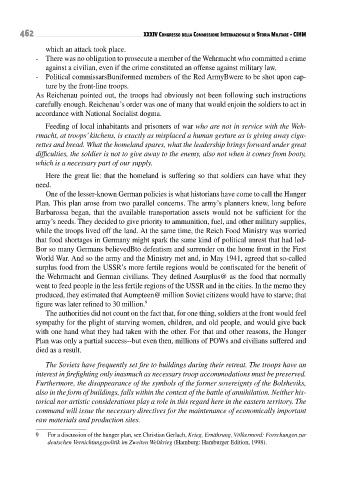Page 462 - Conflitti Militari e Popolazioni Civili - Tomo I
P. 462
462 XXXIV Congresso della CommIssIone InternazIonale dI storIa mIlItare • CIHm
which an attack took place.
- There was no obligation to prosecute a member of the Wehrmacht who committed a crime
against a civilian, even if the crime constituted an offense against military law.
- Political commissarsBuniformed members of the Red ArmyBwere to be shot upon cap-
ture by the front-line troops.
As Reichenau pointed out, the troops had obviously not been following such instructions
carefully enough. Reichenau’s order was one of many that would enjoin the soldiers to act in
accordance with National Socialist dogma.
Feeding of local inhabitants and prisoners of war who are not in service with the Weh-
rmacht, at troops’ kitchens, is exactly as misplaced a human gesture as is giving away ciga-
rettes and bread. What the homeland spares, what the leadership brings forward under great
difficulties, the soldier is not to give away to the enemy, also not when it comes from booty,
which is a necessary part of our supply.
Here the great lie: that the homeland is suffering so that soldiers can have what they
need.
One of the lesser-known German policies is what historians have come to call the Hunger
Plan. This plan arose from two parallel concerns. The army’s planners knew, long before
Barbarossa began, that the available transportation assets would not be sufficient for the
army’s needs. They decided to give priority to ammunition, fuel, and other military supplies,
while the troops lived off the land. At the same time, the Reich Food Ministry was worried
that food shortages in Germany might spark the same kind of political unrest that had led-
Bor so many Germans believedBto defeatism and surrender on the home front in the First
World War. And so the army and the Ministry met and, in May 1941, agreed that so-called
surplus food from the USSR’s more fertile regions would be confiscated for the benefit of
the Wehrmacht and German civilians. They defined Asurplus@ as the food that normally
went to feed people in the less fertile regions of the USSR and in the cities. In the memo they
produced, they estimated that Aumpteen@ million Soviet citizens would have to starve; that
figure was later refined to 30 million. 9
The authorities did not count on the fact that, for one thing, soldiers at the front would feel
sympathy for the plight of starving women, children, and old people, and would give back
with one hand what they had taken with the other. For that and other reasons, the Hunger
Plan was only a partial success--but even then, millions of POWs and civilians suffered and
died as a result.
The Soviets have frequently set fire to buildings during their retreat. The troops have an
interest in firefighting only inasmuch as necessary troop accommodations must be preserved.
Furthermore, the disappearance of the symbols of the former sovereignty of the Bolsheviks,
also in the form of buildings, falls within the context of the battle of annihilation. Neither his-
torical nor artistic considerations play a role in this regard here in the eastern territory. The
command will issue the necessary directives for the maintenance of economically important
raw materials and production sites.
9 For a discussion of the hunger plan, see Christian Gerlach, Krieg, Ernährung, Völkermord: Forschungen zur
deutschen Vernichtungspolitik im Zweiten Weltkrieg (Hamburg: Hamburger Edition, 1998).

